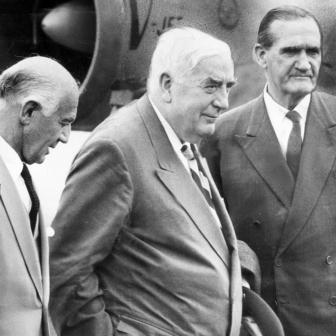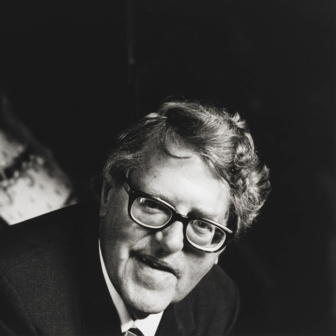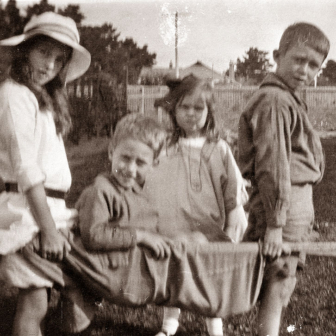It was a strange little film from the beginning; now, as I write, it is almost sixty years old. Once upon a time, as a newspaper cadet — picking up a free ticket which nobody else in the office wanted — I sat in the Shell company’s Sydney theatrette and watched, with complete astonishment, a story about an outback postman taking mail and supplies across the Central Australian desert: a production from the Shell Film Unit, but hardly a film you could describe as promotion for a brand of petrol.
Its visions of space and desert had a kind of radiance, and so I came out from that screening feeling a new kind of connection with Australia, or rather with a new idea of Australia, the country I was born in, and a country I didn’t know. Though I’d taken in some lively documentaries in student film society screenings — a few things like Harry Watt and Basil Wright’s wonderful Night Mail, and Fires Were Started, Humphrey Jennings’s great wartime poem on London under the blitz — I didn’t expect anything really engaging from Australian documentary; I thought it was all mere information (how they make paper, how they built bridges, the life-cycle of the koala).
The strangeness of the work I’d just seen had to do with an extraordinary orchestration of document with re-enactment, and with the storytelling offered by its characters. Through many viewings since, John Heyer’s The Back of Beyond keeps its emotional charge, even while it changes with history and distance, seeming to connect differently each time with the moment in which I’m watching. I don’t know how often I’ve seen it, through the decades of its life and mine; I’ve used it in both adult education and university classes, in courses with names like Film and Politics and Images of Australia.
I watch it again in January 2012 with an acutely critical companion, who first saw it as an immigrant schoolboy sometime in the early 1960s. Now he finds it astonishing, and wonders why anyone ever took its images, its version of things, for granted; and both of us stare into the film’s date, 1954. We say: but this was the last minute before television! and the date matters; a few years later, The Back of Beyond would have been impossible — or at least, a very different project. The documentary tradition which shaped both its visible perspectives and its spoken language (the overriding, voice-of-God commentary) was coming to its end.
The pre-television documentary genre matches visual with verbal poetry; takes care of pictorial values, considers composition in every shot, and looks at individuals and society with a careful, humane benevolence. When Eric Else wrote in 1968 that The Back of Beyond was probably “the last of the great romantic documentaries” he was looking back across the technological and cultural divide to the British poetic documentary movement of the 1930s and 40s, and such films as Coal Face, Night Mail, Listen to Britain, Fires Were Started, and perhaps further back to the early work of the American pioneer Robert Flaherty in Nanook of the North and Moana.
That tradition, which was absorbed and taken seriously by John Heyer, has often been called Griersonian, in salute to the lasting influence of the founding father whose purposeful social ethic and instructional style had shaped British documentary from the early 1930s. John Grierson, running film units within government bureaucracies, practised a definite, teacherly philosophy: the documentary was to be promoted and pursued not for its own sake, but for democracy and social betterment, and especially for the sake of international dialogue and understanding. Grierson’s sisters, Ruby and Marion Grierson, were also documentary film-makers, whose work should be better-known.
But founders and teachers are often left behind; in the most vividly enduring films from Grierson’s group, ethics and aesthetics come together, and the instructional intent drops away. Like those, The Back of Beyond is a crafted essay, a highly planned exploration. From the outset, it was intensively written; Heyer’s wife Janet, herself an artist, had a hand in the script; so did two eminent Australian poets, Douglas Stewart, then literary editor of the weekly Bulletin, and Roland Robinson.
While the film is centred on one person, there’s no interest in psychology or biography; we take our truck driver as we find him, as he is. The Griersonian director doesn’t probe. Nor does he (it was almost never she) trade in politics; the liberal values of civil society, with consensus round the twinned ideas of democracy and progress, are always to be assumed.
My viewing companion observed that John Heyer was interestingly apolitical, that he was aiming for a broad human picture, and that in consequence the Aboriginal presence in the film’s story was something calmly taken on: as the film sees Aboriginal people, they belong. They’re not seen as involving “social problems” (in the language of that day), nor as desolate and marginal; they share the world of the Track, and most of the time they’re sharing its work.
In that particular respect, the film upsets our stereotypes of the 1950s. It offers a special field of vision, and within its framework it is not racist; that very fact is part of its eloquence over the long term, its potency for us in the twenty-first century.
Decades on from that first viewing, screening The Back of Beyond with students, I faced a startling mix of responses. Some loved it, while others thought it was truly awful; heavy-handed, inflated like a sermon, out of date. The sense of elocutionary strain in the re-enactments doesn’t help. At those points the students laughed at the film’s awkwardness; and when the solitary snake winds across the moonlit sand they said hey, that one was let out of somebody’s hessian bag for sure. They laughed quite differently at the surreal comedy in the camp, when Tom dances with the headless model. I had to do some talking then about pre-televisual styles in documentary, about the inheritance from Grierson, about the love of intensely calculated “composition” in images and highflown spoken commentary — always in ABC/BBC male voices. In all that I had to learn something more myself about what it means to be watching film historically. It means not only watching in the knowledge that the lives we meet along the Birdsville Track are being lived in the early 1950s, but also that the film-maker’s ways of seeing belong in that time as well.
At the 1954 Venice film festival, The Back of Beyond won the Grand Prix Assoluto, the award for the best film across all categories; it was praised for “the perfect blending of words, sounds and images.” In the same year, as a documentary offered not as a support but as a feature, it was part of the first Sydney Film Festival, joining Rossellini’s Germany Year Zero, Jacques Tati’s Jour de Fête and René Clair’s Sous les Toits de Paris: all revelations, all extending consciousness of the range and possibilities of cinema. David Donaldson, the festival’s founding director, remembers:
We knew that he [Heyer] had been away a lot making it, indeed had given up chairing the festival committee. We had little idea what the film might be, certainly no thought of what it would become in release. Heyer kept being not quite ready with a print, week after week. I understand that at Supreme Sound he made thirty-three, or perhaps it was thirty-six, trial prints to get the best settings. The final, and marvellous, result came to hand with only days to spare.
There were more prizes, diplomas at festivals in Edinburgh, Capetown, Johannesburg and Trento, and a first prize at Montevideo in 1956. In Australia it was seen by some 750,000 people in its first two years, and by schoolchildren everywhere for at least a decade after that. The film scholar Brian Shoesmith — who also was an English immigrant then – remembers how he had not been in Australia very long as a child when
suddenly the school was closed down so we could all trot off to the local shire hall in Bunbury [WA] to see The Back of Beyond… So it was circulated as an exemplary text for children to see to understand something of this nation. It was a very strange experience for a thirteen- or fourteen-year-old English kid to be suddenly pulled out of school to partake of this national ritual.
On its first appearances, large claims were made; it was praised for unforced humour, for balancing poetry, imagination and realism. The philosopher Alan Stout, one of the most energetic proponents of Australian film, called it “a landmark in Australian documentary” and the Manchester Guardian went further: “one of the most remarkable documentaries ever made.” An unnamed reviewer in the BBC’s weekly, the Listener, wrote that documentary “has rarely been less self-conscious or more enthralling.” “Once more,” wrote Dilys Powell in the London Sunday Times, “the Shell film-makers revive faith in documentary.” She also wrote that the film showed “a landscape where man is always solitary, always on the defensive against Nature.” The Sydney Morning Herald’s anonymous reviewer wrote that the film “is bound to rank as an Australian masterpiece [while] the message… is by no means one of unrelieved horror and pessimism. There is much hopefulness in the unaffected courage and the humour it finds among the people who live along the Birdsville Track.”
That local comment might have been intended as reassurance for suburban audiences who might find the desert story confronting. Watching and reading now, the most interesting of those early comments is the Listener’s:
The final effect is a wholly convincing search for truth and much skill in presenting it… A vividly fascinating film which sheds a forbidding light on Australian realities and darkens one’s suspicions of the universe…
So The Back of Beyond established itself as a film always to be taken as a key moment in Australian film history in general, not only in the special register of documentary. It also remains alive in those spaces where film is understood as bearing on wider histories, as a story and a group of images that count in national self-understanding; and so it became a film that people love and remember. Much of what’s being delivered is — after all — an array of reassuringly ordinary, knowable human figures; and yet we’re still looking at the foreign country of the desert in mid-century, and at moments it seems immeasurably distant.
In the documentary canon, it retains its status, and it’s because of this film that John Heyer has been called “the father of Australian documentary.” He was born in Devonport, Tasmania, in 1916, to a certain level of privilege; his father was a doctor, and he was educated at Scotch College, one of Melbourne’s high-ranking private schools for boys. He seems to have been a cinephile from the outset; while serving an apprenticeship to a firm of scientific instrument-makers, he went to night school to learn film projection and sound-recording.
At eighteen, he worked briefly for Efftee Films, Frank Thring’s company, which went out of business in 1935; Heyer then joined Cinesound Productions, and in the following two years worked as a camera assistant and assistant sound-recordist on three features, Charles Chauvel’s ambitious but unsuccessful epic Heritage, Ken Hall’s Thoroughbred, and Edward G. Bowen’s White Death. In 1940 he was one of the four-member camera team for exteriors on Chauvel’s best and biggest enterprise, Forty Thousand Horsemen, with Frank Hurley, Bert Nicholas and Tasman Higgins (the principal cinematographer was George Heath). In 1942, he married Dorothy Greenhalgh, who was always known as Janet; they had two daughters and a son.
Then, in 1944, Harry Watt made him second-unit director on The Overlanders, and the experience was decisive. Heyer went with his cameraman 2500 kilometres along the Murranji track, from Western Australia across the Northern Territory and into Queensland; with the footage from that journey, he said, Harry Watt “was able to exploit one of the most cinematic of themes — Man against Nature,” and so “gave himself a sweep of the country that ranged from open grass plains to rugged valleys and that typified by its hard, bright light and endless horizon, by its slender ghost-gums and eroded hills, the shapes and forms that are the essential Australia.”
Thus in his early career Heyer worked with the small, beleaguered Australian industry’s most esteemed professionals; and film was his intellectual world as well. With his close friend, the great cinematographer Damien Parer, he read film criticism and theory in such journals as the American Experimental Cinema and the English Close-Up, Monthly Film Bulletin and the rigorous, wide-ranging Penguin Film Review. He was active in the then-thriving film society movement; he was president of the Sydney Film Society and also of the Australian Council of Film Societies, and he argued strongly for government involvement in national film production.
The film was launched nationally; Shell did much more than run screenings in Sydney. A new theatrette was opened in Brisbane, where The Back of Beyond ran for a year; town halls and school halls were hired; tickets were handed out at the company’s petrol stations everywhere. In consequence, a production which was non-theatrical, in the sense that it had no presence on the commercial cinema circuits, was received and reviewed all over the country. The Tumbarumba Times commented that after taking in the film’s account of the desert roads and tracks, the gibber plains and merciless heat, readers should understand that Tumbarumba “wasn’t such a bad place after all.”
Guardians, Chronicles, Expresses, Heralds and Advertisers from Broken Hill to Innisfail, from Echuca to Northam, from Cairns to Kalgoorlie, all noted and commented on the screenings of The Back of Beyond in their school halls and local cinemas; they still had them then. From the commentary then, in the film’s own day, it was clear that audiences reacted to the film’s double aspect: the dimension figured by the desert in both visual and verbal poetry, the dimension of loss; and on the other side the balancing reassurance, centred on Tom Kruse, the women at the radio, their wholeness and ordinariness.
Through them, the outback was almost domesticated for audiences whose schooling had taken in the exploring sagas from the nineteenth century, and with them ideas of the desert as terrifying; “the great Australian loneliness” in the words of the popular travel-writer Ernestine Hill. The “vanishing race” was marginal; the major figures were pioneers and explorers. Everyone knew how the naturalist-explorer Ludwig Leichhardt had been lost forever, gone to an unknown grave; everyone knew the more terrible history of Burke and Wills, so tantalisingly close to survival when they met their deaths. In 1957 Patrick White’s Voss — a stunning transformation of the Leichhardt mystery — intensified those stories, to the point where history and myth become entangled. In that framework, The Back of Beyond made the outback a more bearable presence; part of a known Australia for those who were never likely to go there, but who still wanted to carry a sense of their own country as one stretching away beyond the suburbs into difficulty and adventure.
Grounded in its local meanings, the film moved off into the world, which was also the world of the Cold War. Public discourse was pervaded by the notion of the Communist menace. Behind the sunny, expansive landscapes being offered to postwar Australian society, there was the backdrop of political threat, intensified by the nightmare spectre of atomic warfare, the imagery of roiling mushroom clouds. And those were quite close; not long after The Back of Beyond came into circulation, the atomic tests began in the South Australian desert at Maralinga and Emu Field, sites far southwest of the Track, but still not too far outside the film’s horizons.
For that reason, too, its images of good humour and resourcefulness, the small triumph of Tom’s arrival in Birdsville, made it even more welcome to its audiences in that time; a kind of normality was affirmed. •
This is an edited extract from The Back of Beyond, part of the Australian Screen Classics series, edited by Jane Mills and published by Currency Press.





